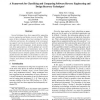Free Online Productivity Tools
i2Speak
i2Symbol
i2OCR
iTex2Img
iWeb2Print
iWeb2Shot
i2Type
iPdf2Split
iPdf2Merge
i2Bopomofo
i2Arabic
i2Style
i2Image
i2PDF
iLatex2Rtf
Sci2ools
WCRE
1999
IEEE
1999
IEEE
A Framework for Classifying and Comparing Software Reverse Engineering and Design Recovery Techniques
Several techniques have been suggested for supporting reverse engineering and design recovery activities. While many of these techniques have been cataloged in various collections and surveys, the evaluation of the corresponding support tools has focused primarily on their usability and supported source languages, mostly ignoring evaluation of the appropriateness of the by-products of a tool for facilitating particular types of maintenance tasks. In this paper, we describe criteria that can be used to evaluate tool by-products based on semantic quality, where the semantic quality measures the ability of a by-product to convey certain behavioral information. We use these criteria to review, compare, and contrast several representative tools and approaches.
Corresponding Support Tools | Design Recovery Activities | Semantic Quality | Software Engineering | WCRE 1999 |
| Added | 04 Aug 2010 |
| Updated | 04 Aug 2010 |
| Type | Conference |
| Year | 1999 |
| Where | WCRE |
| Authors | Gerald C. Gannod, Betty H. C. Cheng |
Comments (0)

